View in other NatureServe Network Field Guides
NatureServe
Montana
Utah
Wyoming
Idaho
Wisconsin
British Columbia
South Carolina
Yukon
California
New York
Ballhead Ipomopsis - Ipomopsis congesta ssp. crebrifolia
Other Names:
Ballhead Gilia, Ball-head Standing-cypress, Compact Gilia,
Gilia congesta var. crebrifolia
State Rank Reason (see State Rank above)
Rare and peripheral in Montana. Currently known from only a small geographic area encompassing parts of the Centennial Mountains to the Monida Pass area in southwest Montana. Additional data on population levels are needed, though it is expected that populations are stable. Potential threats to the known occurrences appear to be minimal or non-existent at the current time.
- Details on Status Ranking and Review
Population Size
Score1-2 - Small to Moderate. Population size is imprecisely known but is believed to be >2,000 individuals and <100,000 individuals.
Range Extent
Score3 - Local Endemic or Very Small Montana Range: Generally restricted to an area <10,000 sq. miles (equivalent to the combined area of Phillips and Valley Counties) or <6 Sub-basins (4th code watersheds) Range-wide OR limited to one Sub-basin in Montana
Area of Occupancy
Score2 - Low: Generally occurring in 4-10 Subwatersheds (6th Code HUC’s).
Environmental Specificity
Score1-2 - Moderate to High.
Trends
ScoreNA - Rank factor not assessed.
Threats
Score0-1 - Low to Medium.
Intrinsic Vulnerability
Score0-1 - Low to Moderate Vulnerability.
Raw Conservation Status Score
Score
7 to 11 total points scored out of a possible 16 (Rarity factors and threats only).
General Description
Ballhead Gilia is an herbaceous, sometimes mat-forming perennial with several ascending to nearly prostrate, usually unbranched stems that are up to 12 cm tall and arising from a branched rootcrown. The strap-shaped, entire-margined, basal leaves are up to 2 cm long, but the alternate stem leaves become smaller upward. Foliage is light green and glabrous. Numerous flowers are borne in a spherical cluster at the tops of the stems. The white, tubular corolla is 3-4 mm long and flares into 5 lobes at the mouth; the 5 anthers are held just beyond the mouth. The calyx tube has 5 pointed lobes. The fruit is a rounded capsule that is 2-4 mm long and has 1-3 seeds.
Phenology
Flowering in June-July, fruiting in late July.
Diagnostic Characteristics
The entire leaves and sprawling habit separate this from other species of Ipomopsis. Colloima debilis will also form loose mats, but the flowers are not so tightly clustered.
Species Range
Montana Range
Range Descriptions
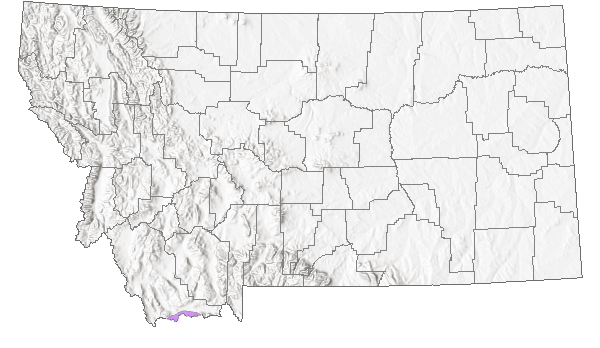
 Native
Native
Range Comments
Regional endemic of southwestern Montana, western Wyoming, western Utah, and northern New Mexico.
Observations in Montana Natural Heritage Program Database
Number of Observations: 19
(Click on the following maps and charts to see full sized version)
Map Help and Descriptions
Relative Density
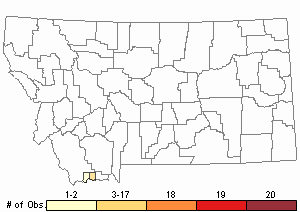
Recency
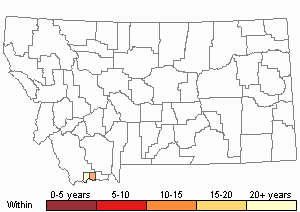
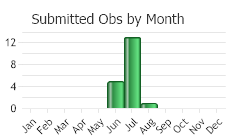
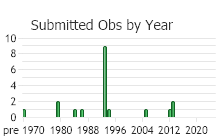
 (Observations spanning multiple months or years are excluded from time charts)
(Observations spanning multiple months or years are excluded from time charts)
Habitat
Open, often eroding sandy soil of sagebrush steppe in the foothill zone.
Ecological Systems Associated with this Species
Ecology
POLLINATORS The following animal species have been reported as pollinators of this plant species or its genus where their geographic ranges overlap:
Bombus occidentalis (Pyke et al. 2012).
Threats or Limiting Factors
STATE THREAT SCORE REASON
Threat impact not assigned because threats are not known (MTNHP Threat Assessment 2021).
References
- Literature Cited AboveLegend:
 View Online Publication
View Online Publication Pyke, G.H., D.W. Inouye, and J.D. Thomson. 2012. Local geographic distributions of bumble bees near Crested Butte, Colorado: competition and community structure revisited. Environmental Entomology 41(6): 1332-1349.
Pyke, G.H., D.W. Inouye, and J.D. Thomson. 2012. Local geographic distributions of bumble bees near Crested Butte, Colorado: competition and community structure revisited. Environmental Entomology 41(6): 1332-1349.
- Additional ReferencesLegend:
 View Online Publication
View Online Publication
Do you know of a citation we're missing? Culver, D.R. 1993. Sensitive plant species inventory in the Centennial Valley, Beaverhead County, Montana. Unpublished report to the Butte District, Bureau of Land Management. Montana Natural Heritage Program, Helena, 42 pp. plus appendices.
Culver, D.R. 1993. Sensitive plant species inventory in the Centennial Valley, Beaverhead County, Montana. Unpublished report to the Butte District, Bureau of Land Management. Montana Natural Heritage Program, Helena, 42 pp. plus appendices. Culver, D.R. 1994. Floristic analysis of the Centennial Region, Montana. M.Sc. Thesis. Montana State University, Bozeman. 199 pp.
Culver, D.R. 1994. Floristic analysis of the Centennial Region, Montana. M.Sc. Thesis. Montana State University, Bozeman. 199 pp. Lesica, P., M.T. Lavin, and P.F. Stickney. 2012. Manual of Montana Vascular Plants. Fort Worth, TX: BRIT Press. viii + 771 p.
Lesica, P., M.T. Lavin, and P.F. Stickney. 2012. Manual of Montana Vascular Plants. Fort Worth, TX: BRIT Press. viii + 771 p. Lesica, P., M.T. Lavin, and P.F. Stickney. 2022. Manual of Montana Vascular Plants, Second Edition. Fort Worth, TX: BRIT Press. viii + 779 p.
Lesica, P., M.T. Lavin, and P.F. Stickney. 2022. Manual of Montana Vascular Plants, Second Edition. Fort Worth, TX: BRIT Press. viii + 779 p.
- Web Search Engines for Articles on "Ballhead Ipomopsis"





